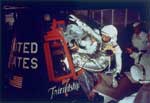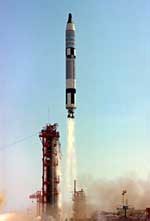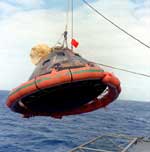.gif)
|
Man in Space
A National Historic Landmark Theme Study |

|
M. Spacecraft
26a. Mercury Spacecraft Friendship 7 — Phase II addition
26b. Gemini 4 Spacecraft — Phase II addition
26c. Apollo 11 Command Module — Phase II addition
The Mercury Spacecraft Friendship 7, Gemini 4 Spacecraft, and the Apollo 11 Command Module are recommended for recognition as nationally significant historic objects although not specifically as National Historic Landmarks because it is thought inappropriate to designate objects in a museum collection displayed in a museum building rather than on a site more suggestive of its historic setting. On the other hand, it is important to recognize the national significance of objects having internal integrity which have contributed critically to the success of the space program and, together, form an integral chapter in that program's story.
These three spacecraft are nationally significant because they represent the three classes of spacecraft that were constructed to carry Americans into space and eventually to the first manned landing on the moon in July 1969. The three spacecraft are the actual flight articles and were used on their respective missions. They each carried one or more crew members and were the only parts of the spaceflight hardware to survive. Each of these spacecraft represents either the first in its series or the most significant in its series. For example, Friendship 7 carried John Glenn into space in February 1962 as the first American to orbit the Earth; Gemini 4 carried Edward White for the first American "space walk," and Apollo 11 carried Neil Armstrong, Buzz Aldrin and Michael Collins on the first successful mission to land on the moon. In recognition of these achievements each of these spacecraft is now housed in the Milestones of Flight Gallery of the National Air and Space Museum in Washington.
 |
 |
 |
| Friendship 7 and Astronaut John Glenn (NASA) |
Gemini 4 Launch (NASA) |
Apollo 11 Command Module being loaded onto USS Hornet (NASA) |
All photos used on this page courtesy of NASA.
Last Modified: Mon, Jan 8 2001 10:00:00 am PDT
man-in-space/spacem.htm

 Top
Top